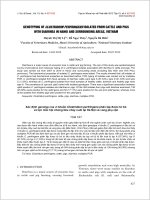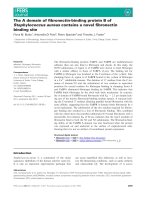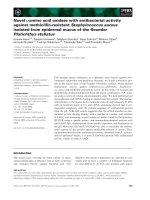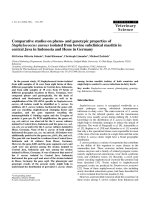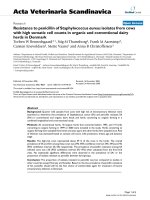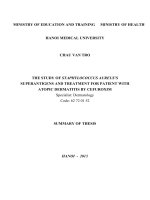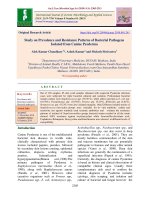Prevalence and resistance pattern of staphylococcus aureus isolated from a al-hussain teaching medical city, Al-zahraa hospital, and obstetric teaching hospital in Karbala governorate, Iraq
Bạn đang xem bản rút gọn của tài liệu. Xem và tải ngay bản đầy đủ của tài liệu tại đây (198.33 KB, 7 trang )
Int.J.Curr.Microbiol.App.Sci (2018) 7(6): 3675-3681
International Journal of Current Microbiology and Applied Sciences
ISSN: 2319-7706 Volume 7 Number 06 (2018)
Journal homepage:
Original Research Article
/>
Prevalence and Resistance Pattern of Staphylococcus aureus Isolated from a
Al-Hussain Teaching Medical City, Al-Zahraa Hospital, and Obstetric
Teaching Hospital in Karbala Governorate, Iraq
Abdul Hussain Sahib Kadhim*
College of Medicine, Karbala University, Iraq
*Corresponding author
ABSTRACT
Keywords
Antimicrobial
susceptibility, Prevalence,
Antibioticresistance,
Staphylococcus
Article Info
Accepted:
25 April 2018
Available Online:
10 June 2018
Staphylococcus aureus continues to be a dangerous pathogen for both community-acquired
as well as hospital-associated infections. The aim of this study was to determine the
prevalence and antibiotic susceptibility of S. aureus and Methicillin Resistant S.
aureus (MRSA) in the environments of three hospitals in Karbala, Iraq. To study the
prevalence of resistant strains of S. aureus isolated from the environments of three
hospitals in Karbala, Iraq. A total of 200samples were collected exudative specimens such
as Pus, Wound swabs, Blood, Throat swabs, and urine obtained from cultures of specimens
from patients who had been hospitalized for 48 hours. The swab samples were directly
plated on Mannitol Salt and Baird Parker agar plates and incubated at 37 °C (± 2) for 18–
24 h. An antibiotic susceptibility test was performed using the Clinical Laboratory
Standard Institute’s guidelines. A total number of 200 clinical samples were processed
which included 45Pus, 40 Wound swabs, 35 Blood, 30 Throat swabs, 50 Urine. Of the
entire number of clinical samples processed, only 200 samples were found positive for
bacterial growth. The prevalence of Staphylococcus aureus in the culture positive samples
was found 44% (88). Coagulase negative staphylococci, 29.16% (7) and 62.22% (38)
Gram negative bacilli. The incidence of S. aureus in the types of clinical samples
Methicillin-resistant S. aureus had high prevalence among Iraqi patients which were
admitted in Hospitals, which indicate their predominance in our community. Accurate and
continuous surveillance of antibiotic resistance patterns among S. aureus strains should be
considered in emergency health care centers.
Introduction
Staphylococcus aureus has long been
considered as a major pathogen of hospital
infections all-around the world. It has been
associated
with
bacteremia,
infective
endocarditis and various types of infections
including skin and soft tissue, osteoarticular,
pleuropulmonary, urinary tract and device-
related (Shrestha et al., 2009; Megged, 2014;
Yahaghi et al., 2014). The ability of S. aureus
to develop resistance to certain environmental
conditions and also wide range of antibiotics
and disinfectant agents. Bacteria have been
implicated as a cause of long-term survival
pathogens in the environment (Holland, 2014).
Methicillin resistant S. aureus (MRSA), has
emerged as a nosocomial pathogen of major
3675
Int.J.Curr.Microbiol.App.Sci (2018) 7(6): 3675-3681
worldwide importance and is an increasingly
frequent cause of community-acquired
infections that cause significant morbidity and
mortality ((Rubin et al., 1999). In 1961, there
were reports from the United Kingdom of S.
aureus isolates, which resisted to methicillin,
and MRSA isolates were soonrecovered from
other European countries, and later from
Japan, Australia, and the United States (CDC,
1999).
MRSA is a resistant variant of Staphylococcus
aureuswhich has evolved an ability to survive
treatment with beta-lactam antibiotics which
includes
penicillin,
methicilllin
and
cephalosporins and to various other groups of
antimicrobial agents. They are often referred
to as superbugs. Most isolates remain
susceptible to Glycopeptides (Vancomycin,
Teicoplanin), Oxazolidinones (linezolid)
Streptograminins (quinupristin-dalfopristin),
and polycyclic compounds (tetracycline,
tigecycline) (Moreillo et al., 2005; Deresinski,
2005). The synthesis of large numbers of
antibiotics over the past three decades has
caused complacency about the threat of
bacterial resistance. Bacteria have become
resistant to antimicrobial agents as a result of
chromosomal changes or the exchange of
genetic material via plasmids and transposons
(Rubin et al., 1999). Resistance to antibiotics
is a significant worldwide problem and
antibiotic use is being recognized as the key
selective force driving this resistance
(Kreiswirth et al., 1993; Sehhati et al., 2009).
Traditionally,
MRSA
was
identified
infrequently from patients in the community,
but over the last few years reports have
documented increases in community-acquired
MRSA, which may suggest a changing in
epidemiology (Kallen
et
al.,
2000;
Ghojazadeh et al., 2014).
In Iraq, several studies were carried out
regarding the prevalence and antimicrobial
resistance of MRSA from different clinical
materials, but little is known about these
bacteria in patients with health care centre. For
that this study was designed to detect the
prevalence and antimicrobial resistance
pattern of MRSA isolates from Iraqi patients
admitted in Al-Hussain Teaching medical city,
Al-Zahraa hospital, and Obstetric teaching
hospital in Karbala governorate / Iraq.The aim
of this research was to study the prevalence of
S. aureus infections in the Karbalahospitals
and the drug resistance pattern in the isolates
with an intension to help start the appropriate
empirical antibiotic treatment of patients even
on the levels of primary healthcare centers
Materials and Methods
Study Design
Staphylococcus aureus strains isolated from
cultures of specimens from patients who have
been hospitalized for > 48 hours in Al-Hussain
Teaching medical city, Al-Zahraa hospital,
and Obstetric teaching hospitals in Karbala
governorate / Iraq were included in the study.
Isolation and Identification of Clinical
Specimens
The samples were collected exudative
specimens such as Pus, Wound swabs, Blood,
Throat swabs, and urine obtained from
cultures of specimens from patients who had
been
hospitalized
for
48
hours.
Staphylococcus aureus were characterized by
their morphology on Gram staining, growth
characteristics and coagulase production. The
study was carried out between November
2017 to December 2017.
Antimicrobial Susceptibility Testing
The antibiotic susceptibility pattern of all the
confirmed S. aureus were determined by
Kirby-Bauer disc diffusion method against the
following antibiotics as per CLSI guidelines:
3676
Int.J.Curr.Microbiol.App.Sci (2018) 7(6): 3675-3681
Octadisc (combi 68). Cefoperazone (75 mcg),
Cefpodoxime (30mcg), Ceftazidime (30mcg),
Cefepime (30mcg), Meropenem (10mcg),
Gentamicin (10 mcg), Amikacin (30 mcg) and
Moxifloxacin (5 mcg). Muller-Hinton agar
used to perform all antimicrobial susceptibility
tests, and the interpretation criteria were taken
according to National Committee for Clinical
Laboratory Standard (NCCLS).
Screening for MRSA
Methicillin resistance was screened by disc
diffusion method using 30μg cefoxitin disk
(Becton Dickinson). The diameter of the zone
of inhibition was measured and interpretation
was done in accordance with the CLSI
guidelines.
An isolate was considered to be a MRSA
strain if cefoxitin inhibition zone diameter was
< 21 mm (CLSI, 2007).Since Staphylococcus
aureus can be a colonizer (Madani, 2002;
Moreillon and Glauser, 2005) special
emphasis was laid on the clinical significance
of all the isolates. This was done by
correlating with Gram stained smear
examination and ascertaining significance
with the clinical history.
Results and Discussion
In this study, we describe the incidence of
MRSA isolation in Al-Hussain Teaching
medical city, Al-Zahraa hospital, and
Obstetric teaching hospital in Karbala
governorate / Iraq. We determined the MRSA
incidence in our facility while generating our
hospital antibiogram in support of our
healthcare providers to more effectively treat
their patients. Thus, we determined the
baseline of MRSA prevalence to better inform
incoming healthcare providers. This study
represents the longest survey of MRSA
incidence performed in Karbala governorate in
Iraq.
A total number of 200 clinical samples were
processed which included 45Pus, 40 Wound
swabs, 35 Blood, 30 Throat swabs, 50 Urine.
Of the entire number of clinical samples
processed, only 200 samples were found
positive for bacterial growth. The prevalence
of Staphylococcus aureus in the culture
positive samples was found 44% (88),
Coagulase negative staphylococci, and
29.16% (7) and 62.22% (38) Gram negative
bacilli. The incidence of S. aureus in the types
of clinical samples is shown in Table 1.
The prevalence of MRSA and MSSA in the
clinical samples has been shown in Table 2.
The prevalence of MRSA was found to be
44% (88) in the entire studied population.
S. aureus is a leading pathogen in hospital
acquired infections (HAIs). The prevalence of
S. aureus infections was next to the Gram
negative bacterial infections, but on the top of
Gram positive bacterial infections. However,
as the isolated Gram negative bacterial
pathogens were not identified to their genera
or species level, the S. aureus infections may
be considered the top leading among all the
infections in the observed Bastar population.
All the studied subjects were tribal and native
of Bastar region only, and pyogenic and
urogenital infections were found common in
them. Unhygienic mode of living and least
health awareness might be a cause of ease in
acquiring infections.
Overall resistance patterns of MRSA isolates
included in this study were consistent with
those obtained by other Iraqi researchers
(Mohammed, 2011; Al-Hassnawi et al., 2012),
where the highest resistance rates were against
β-lactam antibiotics, except carbapenems.
Lack of control over antibiotic use in our
country is the main reason for the
development of increasing resistance to
different antimicrobials among our clinical
isolates including MRSA.
3677
Int.J.Curr.Microbiol.App.Sci (2018) 7(6): 3675-3681
Table.1 Prevalence of S. aureus in the culture positive clinical samples
Sample
Samples S. aureus
Coagulase Negative Gram negative
(n)
S. aureus
bacilli
45
24(53.33%)
7 (29.16%)
38 (62.22%)
Pus
34 (85%)
0 (0%)
7 (17.5%)
Wound swabs 40
35
19 (54.28%)
11 (57.89%)
12 (34.28)
Blood
14 (46.66%)
4 (28.57%)
0 (0%)
Throat swabs. 30
50
9 (18%)
3 (33.33%)
41 (82%)
Urine
Table.2 Prevalence of MRSA and MSSA in the clinical samples
Total
clinical samples MRSA
MSSA
(n=200)
88 (44%)
112 (56%)
Pus (n=45)
13 (28.88%)
32 (71.11%)
Wound swabs(n=40)
13 (32.5%)
27 (65.5 %)
Blood(n=35)
18 (51.5)
17 (48.5%)
Throat swabs(n=30)
30 (100%)
0 (0%)
Urine(n=50)
14 (28%)
36 (72.00)
Table.3 Prevalence of MRSA and MSSA in the clinical samples
Total
clinical samples MRSA
MSSA
(n=200)
88 (44%)
112 (56%)
Pus (n=45)
13 (28.88%)
32 (71.11%)
Wound swabs(n=40)
13 (32.5%)
27 (65.5 %)
Blood(n=35)
18 (51.5)
17 (48.5%)
Throat swabs(n=30)
30 (100%)
0 (0%)
Urine(n=50)
14 (28%)
36 (72.00)
Total clinical
samples (n=200)
Pus (n=45)
Wound swabs
(n=40)
Blood (n=35)
Throat swabs
(n=30)
Urine (n=50)
Total (n=200)
Table.4 Pattern of antibiotic resistance (%)
CPZ
CPD
CAZ
CPM
MRP
GEN
AK
MO
23
20
40
42
33
25
18
43
(51.11) (44.44) (88.88) (93.33) (73.33) (55.55)
(40)
(95.55)
34 (85)
33
17
39
31
36
28
26 (65)
(82.5) (42.5) (97.5) (77.5)
(90)
(70)
31
15
19
22
26
27
11
34
(88.57) (42.85) (54.28) (62.85) (74.28) 77.14 (31.42) (37.14)
29
23
18
22
16
19
24
11
(96.66) (76.66)
(60)
(73.33) (53.33) (63.33)
(80)
(36.66)
45 (90)
23
41
23
44
18
37
25
(46)
(82)
(46)
(88)
(36)
(74)
(50)
162
114
135
148
150
125
118
139
(81)
(57)
(67.5)
(74)
(75)
(62.5)
(59)
(69.5)
3678
Int.J.Curr.Microbiol.App.Sci (2018) 7(6): 3675-3681
Fig.1 Pattern of antibiotic resistance of Stapylococcus spp. isolated from clinical samples
Also, overuse of β-lactams for treating
different cases in our hospitals is another
reason for this high prevalence of MRSA.
Emergence of antibiotic-resistant bacteria
clones reflects the intensive use of
antimicrobial agents (Didier et al., 2011). So
that there must be a scheduled rotation of βlactams use with other antimicrobials in the
study area to reduce this high antibiotic
resistance among our isolates.
In a study by Alebachew et al., 2012, the S.
aureus strains of human clinical infections
were sensitive to clindamycin, vancomycin,
erythromycin, and kanamycin but highly
resistant to penicillin. They showed that all
isolates were multi-drug resistant, and one
isolates was resistant to all the tested drugs. In
a research in Iran, 60 % of all S.aureus
isolates of hospital infections were resistant to
methicillin.
Ekrami et al., 2010, showed that the highest
resistance was to ciprofloxacin (81.2 %) while
Momtaz and Hafezi, 2014 found that S.
aureus isolates from hospital infections were
resistant to azithromycin (62.12 %),
tetracycline (57.57 %) and erythromycin
(54.54%).
Methicillin-resistant S.
aureus had
high
prevalence among Iraqi patients which were
admitted in Al-Hussain Teaching medical
city, Al-Zahraa hospital, and Obstetric
teaching hospital in Karbala governorate /
Iraq, which indicate their predominance in our
community. The results of the present
investigation indicate that S. aureus might be
an important causative agent of nosocomial
infections in emergency centers of hospitals.
Accurate and continuous surveillance of
antibiotic resistance patterns among S. aureus
strains should be considered in emergency
health care centers. Effective disinfection of
surfaces, beds, trolleys and surgical
instruments by hospital infection control unit
should be performed periodically to reduce
colonization of S. aureus in various areas of
hospital emergency wards.
References
Alebachew T, Yismaw G, Derabe A, Sisay Z.
(2012). Staphylococcus aureus burn
wound infection among patients
attending yekatit 12 hospital burn units,
addisababa, Ethiopia. Ethiop J Health
Science; 22(3): 209- 213.
3679
Int.J.Curr.Microbiol.App.Sci (2018) 7(6): 3675-3681
Al-Hassnawi HH, Al-Charrakh AH, AlKhafaj JK (2012). Antibiotic resistance
patterns of community acquired
methicillin resistance Staphylococcus
aureus (CA-MRSA) in Al-Hilla/ Iraq.
Kerbala Journal of Pharmaceutical
Sciences 10: 91-102.
Centers for Disease Control and Prevention
(CDC) (1999). Four Pediatric Deaths
from Community-Acquired MethicillinResistant
Staphylococcus
aureusMinnesota and North Dakota, 19971999. Morbidity and Mortality Weekly
Report (MMWR) 1999; 48(32): 707-10.
Clinical Laboratory Standard Institute (2007).
Performance standards for antimicrobial
susceptibility
testing;
Seventeenth
informational
supplement-Clinical
Laboratory Standard Institute M100S17; 27:1.
Deresinski S. (2005). Methicillin-resistant
Staphylococcus aureus: an evolutionary,
epidemiologic,
and
therapeutic
Odyssey. Clin Infect Dis; 40:562-73.
Didier JP, Villet R, Huggler E, Lew DP,
Hooper
DC
(2011). Impact
of
ciprofloxacin
exposure
on
Staphylococcus
aureus
genomic
alterations linked with emergence of
rifampin resistance. Antimicrob Agents
Chemother 55: 1848-1852.
Ekrami A, Samarbafzadeh A, Alavi M,
Kalantar E, Hamzeloi F. (2010).
Prevalence of methicillin resistant
Staphylococcus species isolated from
burn patients in a burn center, Ahvaz,
Iran. Jundishapur J Microbiol; 3(2): 8491.
Ghojazadeh
M,
Naghavi-Behzad
M,
Nasrolah-Zadeh R, Bayat-Khajeh P, Piri
R, and Mirnia K, (2014). Knowledge
production status of Iranian researchers
in the gastric cancer area: based on the
medline database. Asian Pac J Cancer
Prev; 15(12): 5083-8.
Holland TL, Arnold C, Fowler VG, (2014).
Clinical management of Staphylococcus
aureus bacteremia: a review. JAMA;
312(13): 1330-1341.
Kallen AJ, Driscoll TJ, Thornton S, Olson PE,
Wallace MR. (2000). Increase in
community-acquired
methicillinresistant Staphylococcus aureus at a
Naval Medical Center. Infect Control
HospEpidemiol; 21(3): 223-6. Madani
T A. Epidemiology and Clinical
features
of
methicillin-resistant
Staphylococcus aureus in the University
Hospital, Jeddad, Saudi Arabia. Can J
Infect Dis 2002; 13(4): 245-250.
Megged O. (2014). Staphylococcus aureus
urinary tract infections in children are
associated
with
urinary
tract
abnormalities and vesico-ureteral reflux.
PediatrNephrol; 29(2): 269-272.
Mohammed SM (2011). Use of cefoxitin as
indicator for detection of Methicillin
Resistant
Staphylococcus
aureus.
Baghdad Science Journal 8: 947-955.
Momtaz H, Hafezi L. (2014). Meticillinresistant Staphylococcus aureus isolated
from Iranian hospitals: virulence factors
and antibiotic resistance properties.
Bosn J Basic Med Sci; 14(4): 219-226.
Moreillon P, Que Y A, Glauser M P. (2005).
Staphylococcus
aureus
(including
Stapylococcal toxic shock) in Mandell,
Doughlas and Bennett‘s. Principles and
practice of Infectious disease 6th ed.
Churchill Livingstone; 2321-2351.
Rubin RJ, Harrington CA, Poon A, Dietrich
K, Greene JA, Moiduddin A. (1999).
The economic impact of Staphylococcus
aureus infection in New York City
hospitals. Emerg Infect Dis 1999; 5(1):
9-17.
Sehhati-Shafaii F, Asadollahy M, Piri R,
Naghavi-Behzad M, Farzollahpour F.
(2013) Prevalence and Risk Factors of
Preterm Labor in Health Educational
3680
Int.J.Curr.Microbiol.App.Sci (2018) 7(6): 3675-3681
Centers of Northwest Iran. Life Sci J;
10(3): 231-236.
Shrestha B, Pokhrel B, Mohapatra T. (2009).
Study of nosocomial isolates of
Staphylococcus aureus with special
reference to methicillin resistant S.
aureus in a tertiary care hospital in
Nepal. Nepal Med Coll J; 11(2): 123126.
Yahaghi E, Imani Fooladi AA, Amin M,
Mirnejad R, Nezamzade R, Amani J.
(2014). Detection of Class I Integrons in
Staphylococcus aureus isolated from
Clinical Samples. Iran Red Crescent
Med J.; 16(11): e16234.
How to cite this article:
Abdul Hussain Sahib Kadhim. 2018. Prevalence and Resistance Pattern of Staphylococcus
aureus Isolated from a Al-Hussain Teaching Medical City, Al-Zahraa Hospital, and Obstetric
Teaching Hospital in Karbala Governorate, Iraq. Int.J.Curr.Microbiol.App.Sci. 7(06): 36753681. doi: />
3681
